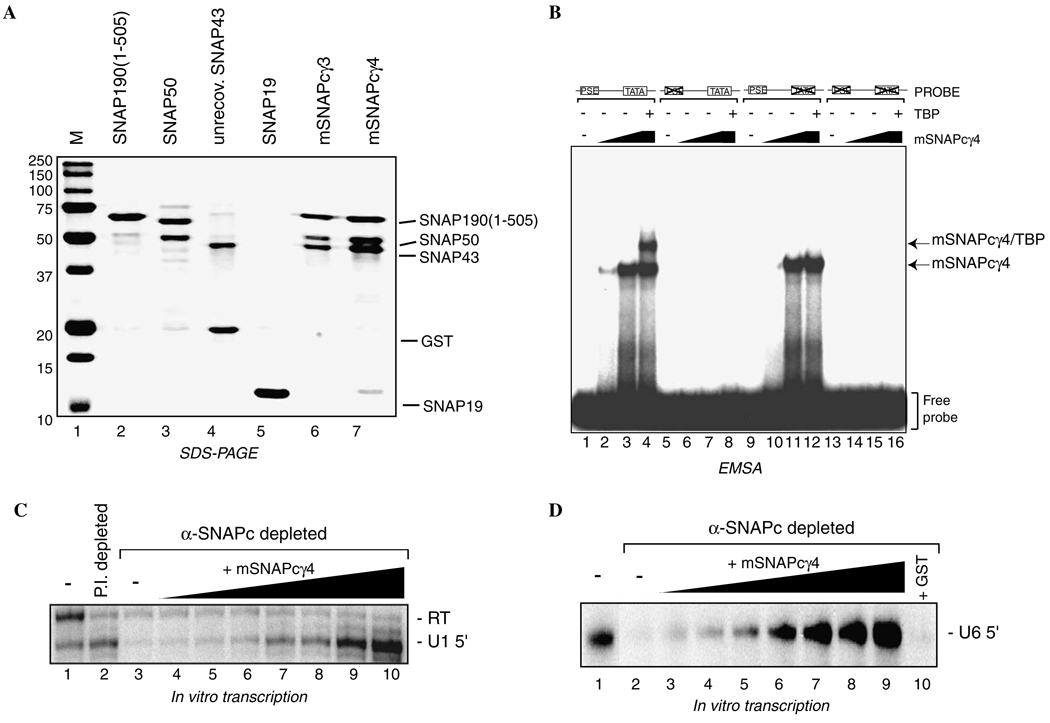Fig. 4.
mSNAPCγ4 functions for DNA binding, TBP recruitment, and in vitro transcription by RNA polymerases II and III. (A) SNAP19 improves complex stability and subunit recovery. Subunit recovery for partial SNAPC assembled without and with co-expressed SNAP19 (mSNAPCγ3 and mSNAPCγ4, respectively) was estimated by SDS–PAGE and Coomassie blue staining. Note the increased recovery of SNAP43 and SNAP50 in mSNAPCγ4 (lane 7) compared to mSNAPCγ3 (lane 6). Lanes 2–5 contain aliquots of the individually expressed SNAPC subunits for reference. (B) mSNAPCγ4 facilitates TBP promoter recruitment. Increasing amounts of mSNAPCγ4 (3 and 10 ng) were added to DNA binding reactions containing radiolabeled probes that harbor a wt PSE and wt TATA box (lanes 1–4), mu PSE and wt TATA box (lanes 5–8), wt PSE and mu TATA box (lanes 9–12), or mu PSE and mu TATA box (lanes 13–16). Lanes 4, 8, 12, and 16 contain 50 ng of recombinant full-length human TBP in addition to 10 ng of mSNAPCγ4. Reactions containing only the DNA probes are shown in lanes 1, 5, 9, and 13. Positions of the mSNAPCγ4 and mSNAPCγ4 plus TBP complexes are indicated. (C) mSNAPCγ4 functions for U1 snRNA transcription by RNA polymerase II. HeLa cell nuclear extract was either mock depleted with a preimmune rabbit sera (lane 2) or α-SNAP43 antisera (lanes 3–10) to deplete endogenous SNAPC. Extracts were then used for human U1 in vitro transcription assays. The U1-specific signal was diminished upon removal of endogenous SNAPC, as shown in lane 3. Increasing amounts of mSNAPCγ4 (0.08, 0.25, 0.75, 2.5, 7.5, 25, and 75 ng) reconstituted the correctly initiated transcription from a human U1 reporter, as shown in lanes 4–10. Lanes 1 and 2 show the U1 signal obtained from either untreated or mock depleted reactions. (D) mSNAPCγ4 functions for U6 snRNA transcription by RNA polymerase III. In vitro transcription of human U6 snRNA was carried out using HeLa cell nuclear extract that was treated as in (C). Lane 2 shows the reduced U6 signal upon removal of endogenous SNAPC. Increasing amounts of mSNAPCγ4 (0.08, 0.25, 0.75, 2.5, 7.5, 25, and 75 ng) reconstituted the correctly initiated transcription from a human U6 reporter as shown in lanes 3–9. Approximately 75 ng of GST was added to the transcription reaction shown in lane 10.

